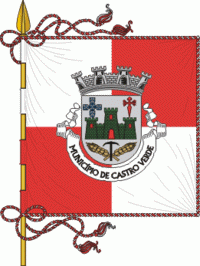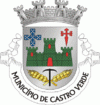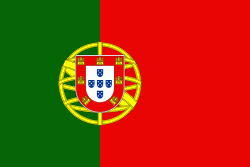Castro Verde Municipality (Castro Verde)
 |
 |
The pre-History of the Baixo Alentejo Subregion dates back to 200,000 B.C. when the territory was crossed by migratory Neanderthal peoples from the north of Europe in the Lower Paleolithic period. Until their extinction, around 28,000 B.C., Neanderthal man hunted and foraged in present-day Portugal. Later, the area was home to several cultures due to the abundance of minerals and its commercial and strategic place along the Mediterranean. The earliest settlements began with Celtiberians, from the central Iberian Peninsula around the 6th Century B.C., and were followed by the Celts. From the 3rd Century, tribal clans were replaced by organized oppidum, a fortified organized city with a defined territory that included many castro villages constructed from large boulders or earthworks.
The first evidence of early cultures in the area of Castro Verde was the discovery of the 'Syllabary of Espança', which was found near the village of Neves-Corvo in the civil parish of Santa Bárbara de Padrões. This archaeological stone contains a Southwest Paleohispanic script, using Tartessian script and language, identified as being the most ancient paleohispanic script; related to the Phoenician alphabet, it is the closest European connection to the Phoenician culture. The Tartessian culture was the precursors of the Turdetani peoples of the Roman period. Growth of settlements during the classic period were likely associated with the strategic importance of the Iberian Pyrite zone. Castro Verde lies along a transport route linking the mines of Aljustrel (20 km to the north) with the port city of Mértola (40 km to the east) situated on tributaries of the Guadiana river. During the Roman occupation, the extensive mining and warehousing of minerals required protective fortifications and mineral warehouses: in the Castro Verde territory there are remains of more than 20 such small structures. Along with mining activities, the area became a vast area of grain production and cattle/sheep-grazing. The richness and abundance of these combined 'base economies' grew to such extent that Castro Verde became a regional centre of commerce and thus a crossroad of cultures within the Mediterranean area.
The name origin of Castro Verde dates back to this early period, with two interpretations cited for its name. One postulates that the name was derived from the Roman Castra Castrorum and combined the verde (meaning "green") to indicate new. A more consistent interpretation is that the name was derived from Castrum Veteris, meaning the oldest castro, to differentiate it from another castro that existed on a small plateau (where the Chapel of São Martinho exists) and was abandoned during the Middle Ages. The term castro derived from the Latin castrum refers to a small military encampment or fortification, built of large rocks.
Roman occupation spanned four centuries and was followed by the migration of the Visigoths (300-700 A.C.) their expulsion by the Moors (in 711), and in turn, their expulsion from the area during the Christian Reconquista. The Battle of Ourique, where Afonso I triumphed over five Moorish Kings occurred in São Pedro das Cabeças, approximately five kilometres from the village of Castro Verde, and paved the way for the creation of the Kingdom of Portugal (in the Treaty of Zamora in 1143). As the legend of the Battle describes, the battle lasted two days (between 24 and 25 July 1139) and was so excessively bloody that the waters of Ribeira de Cobres flowed the color of red. Afonso Henriques who was declared Prince of Portugal, after the Battle of São Mamede, defeated the Moorish kings (at the Battle of Ourique), and was then proclaimed King upon the victory. But, although King Afonso was able to triumph, the region was never definitely secured by the Portuguese until the regin of King Sancho II, around 1234, when the Castle of Aljustrel was captured. Later, the Royal Basilica of Castro Verde was commissioned by King Sebastian of Portugal in 1573 to mark the Christian victory over the Moors, with the walls of the central nave covered in azulejos immortalizing the famous battle.
The region of Castro Verde passed into the possession of the priory of the Comenda de Santiago, and its donatários, the Dukes of Aveiro. Castro Verde continued to operate as the central administrative centre and municipal seat, while Casével and Entradas won administrative autonomy. While mineral extraction continued to drive the economy, herding assumed a fundamental part of the regions economy as well. During the 16th and 17th Century, the Campos de Ourique became the destination for many herds from Castela and Serra da Estrela, creating a new economic, social and cultural dimension to the municipality.
Although the human ecology of this territory has been marked by the settlement of many civilizations all based on mining, cereal cultivation and cattle/sheep grazing, it was only in the beginning of the 14th century that territories became organized as distinct economic entities within the new kingdom. During this post-reconquista era, the vast pasture-lands of the Castro Verde area were granted to nobility by King Denis (the Farmer King) which resulted in the management of thousands of hectares under rotational cultivation to become the bread basket of Portugal and the most important pastureland of the country. Over the centuries, the territory has been continually influenced by a transhumance which has left a unique cultural identity in the form of architecture, arts, music, song, and poetry expressing the daily activities of a people living on the land.
In the middle of the 19th century, the surrounding municipal districts were reorganized and Castro Verde was formalized within its current boundaries: it had received its town charter (Foral) in 1510 by King Manuel I of Portugal. The municipality of Castro Verde developed its own particular cultural identity based on millenniums of interchange between cultural groups. From roots in mining and agricultural, the community has transformed into a city, with future plans focused on the integration of Roman and Islamic architecture in modern eco-architecture. Cultural tourism has resurged to keep alive traditional art, music and poetry indigenous to the territory. The year 2010 marked year-long festivities to celebrate the 500th anniversary of the town charters of Castro Verde and Casével.
Map - Castro Verde Municipality (Castro Verde)
Map
Country - Portugal
 |
 |
| Flag of Portugal | |
One of the oldest countries in Europe, its territory has been continuously settled, invaded and fought over since prehistoric times. The territory was first inhabited by pre-Roman and Celtic peoples who had contact with Phoenicians, ancient Greeks and Carthaginians. It was later ruled by the Romans, followed by the invasions of Germanic peoples and the Islamic invasion by the Moors, whose rule was eventually expelled during the Reconquista. Founded first as a county of the Kingdom of León in 868, gained its independence as the Kingdom of Portugal with the Treaty of Zamora in 1143.
Currency / Language
| ISO | Currency | Symbol | Significant figures |
|---|---|---|---|
| EUR | Euro | € | 2 |
| ISO | Language |
|---|---|
| PT | Portuguese language |















